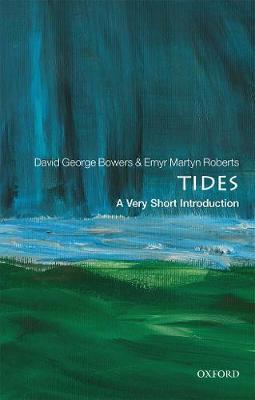Tides: A Very Short Introduction

Tides: A Very Short Introduction
respect by those who live and work by the sea.
In this Very Short Introduction David George Bowers and Emyr Martyn Roberts explore what we know about the tides. Blending clear explanations of well known tidal phenomena with recent insights in the deep ocean and coastal seas, Bowers and Roberts use examples from around the world, to tell the story of the tide, considering its nature and causes, its observation and prediction, and unusual tides and their relevance. They explore why tides have attracted the attention of some of the
world's greatest scientists, from the initial challenge of explaining why there are two tides a day when the moon and sun pass overhead just once; a problem that was solved by Isaac Newton. In the 19th century, scientists unravelled the rhythms of the tide; good tidal predictions in the form of tide tables
were then possible. The predictions were made on beautiful tide predicting machines constructed of brass and mahogany, some of which can still be seen in maritime museums. In the 20th century, the importance of tides as mixers of sea water became evident. As Bowers and Roberts explore, tidal mixing of the ocean is essential for maintaining its deep circulation, a key part of the climate-control system of our planet. In inshore waters, tidal mixing enhances biological productivity, influences
sea temperature and turbidity and creates dramatic features such as maelstroms and tidal bores. In the 21st century, space probes are examining the effects of tidal processes on the moons of Jupiter and Saturn and the possibility of tidally-heated liquid oceans with their own ecosystems. Looking to the
cutting edge of tidal research, Bowers and Roberts also consider how we can study the role of the tide in the geological and biological evolution of our own planet with innovative computer models.
PRP: 80.54 Lei
Acesta este Prețul Recomandat de Producător. Prețul de vânzare al produsului este afișat mai jos.
72.49Lei
72.49Lei
80.54 LeiLivrare in 2-4 saptamani
Descrierea produsului
respect by those who live and work by the sea.
In this Very Short Introduction David George Bowers and Emyr Martyn Roberts explore what we know about the tides. Blending clear explanations of well known tidal phenomena with recent insights in the deep ocean and coastal seas, Bowers and Roberts use examples from around the world, to tell the story of the tide, considering its nature and causes, its observation and prediction, and unusual tides and their relevance. They explore why tides have attracted the attention of some of the
world's greatest scientists, from the initial challenge of explaining why there are two tides a day when the moon and sun pass overhead just once; a problem that was solved by Isaac Newton. In the 19th century, scientists unravelled the rhythms of the tide; good tidal predictions in the form of tide tables
were then possible. The predictions were made on beautiful tide predicting machines constructed of brass and mahogany, some of which can still be seen in maritime museums. In the 20th century, the importance of tides as mixers of sea water became evident. As Bowers and Roberts explore, tidal mixing of the ocean is essential for maintaining its deep circulation, a key part of the climate-control system of our planet. In inshore waters, tidal mixing enhances biological productivity, influences
sea temperature and turbidity and creates dramatic features such as maelstroms and tidal bores. In the 21st century, space probes are examining the effects of tidal processes on the moons of Jupiter and Saturn and the possibility of tidally-heated liquid oceans with their own ecosystems. Looking to the
cutting edge of tidal research, Bowers and Roberts also consider how we can study the role of the tide in the geological and biological evolution of our own planet with innovative computer models.
Detaliile produsului










